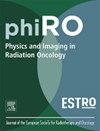Efficient strategy for magnetic resonance image-guided adaptive radiotherapy of rectal cancer using a library of reference plans
IF 3.4
Q2 ONCOLOGY
引用次数: 0
Abstract
Background and purpose
Adaptive radiotherapy for patients with rectal cancer using a magnetic resonance–guided linear accelerator has limitations in managing bladder shape variations. Conventional couch shifts may result in missing the target while requiring a large margin. Conversely, fully adaptive strategy is time-consuming. Therefore, a more efficient strategy for online adaptive radiotherapy is required.
Materials and methods
This retrospective study included 50 fractions from 10 patients with rectal cancer undergoing preoperative radiotherapy. The proposed method involved preparing a library of reference plans (LoRP) based on diverse bladder shapes. For each fraction, a plan from the LoRP was selected based on daily bladder filling. This plan was compared with those generated by conventional couch shift and fully adaptive strategies. The clinical acceptability of the plans (i.e., per protocol, variation-acceptable, or unacceptable) was assessed.
Results
In per protocol criterion, 44 %, 6 %, and 100 % of the plans for LoRP, conventional couch shift, and fully adaptive strategies were achieved, respectively. In variation-acceptable criterion, 92 % of LoRP plans and 74 % of conventional couch shift plans were achieved. LoRP demonstrated 94 % target coverage (100 % prescription dose) in the fully adaptive strategy compared with 91 % in conventional couch shift strategy. The fully adaptive strategy had the best performance in sparing the intestine and colon. LoRP reduced the treatment session duration by more than a third (>20 min) compared with the fully adaptive strategy.
Conclusion
LoRP achieved adequate target coverage with a short treatment session duration, potentially increasing treatment efficiency and improving patient comfort.
基于参考方案库的磁共振图像引导直肠癌自适应放疗的有效策略
背景与目的应用磁共振引导直线加速器对直肠癌患者进行适应性放疗在处理膀胱形状变化方面存在局限性。传统的沙发轮班可能会导致错过目标,同时需要很大的利润。相反,完全自适应策略是耗时的。因此,需要一种更有效的在线适应性放疗策略。材料与方法回顾性研究10例直肠癌术前放疗患者的50个部位。所提出的方法包括基于不同膀胱形状准备参考平面图库(LoRP)。对于每个部分,根据每日膀胱填充情况从LoRP中选择一个计划。将该计划与传统的沙发移位和完全适应策略产生的计划进行比较。评估计划的临床可接受性(即,每个方案,可接受的或不可接受的变化)。结果在每个方案标准中,LoRP、传统沙发移位和完全适应策略的计划分别达到44%、6%和100%。在可变可接受标准中,92%的LoRP计划和74%的传统沙发轮班计划得以实现。在完全适应策略中,LoRP显示94%的目标覆盖率(100%处方剂量),而在传统的沙发轮班策略中为91%。全适应策略在保护肠道和结肠方面表现最好。与完全适应策略相比,LoRP将治疗持续时间缩短了三分之一以上(20分钟)。结论lorp治疗时间短,治疗目标覆盖率高,有可能提高治疗效率,改善患者舒适度。
本文章由计算机程序翻译,如有差异,请以英文原文为准。
求助全文
约1分钟内获得全文
求助全文
来源期刊

Physics and Imaging in Radiation Oncology
Physics and Astronomy-Radiation
CiteScore
5.30
自引率
18.90%
发文量
93
审稿时长
6 weeks
 求助内容:
求助内容: 应助结果提醒方式:
应助结果提醒方式:


